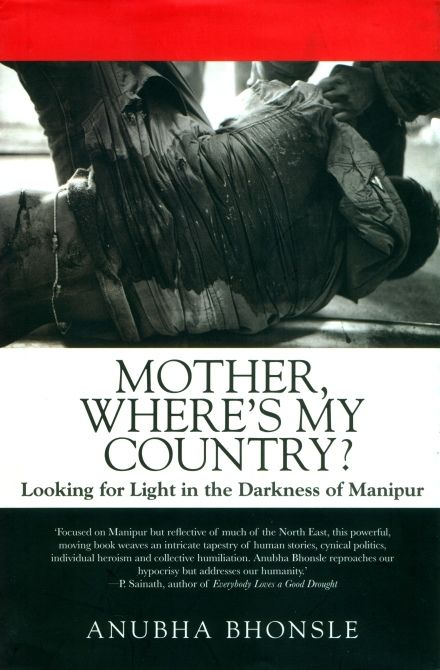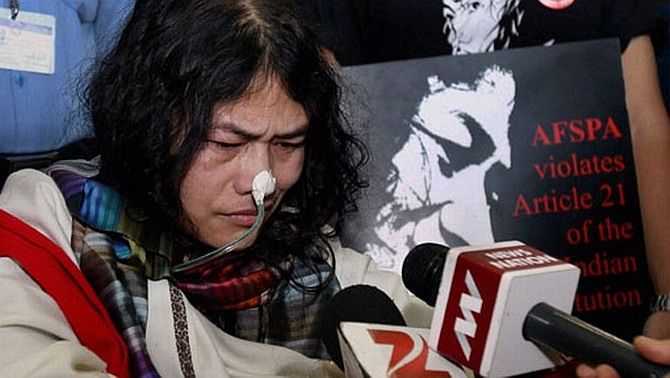'There is a joke that is cracked in hushed tones sometimes in Manipur, what would many of the insurgent outfits do if AFSPA is indeed taken away? What would they fight against?'

The mainstream media rarely covers Manipur -- exceptions being its boxers on the sports pages or the current convulsions in the Congress party -- nor is there interest in the militancy affecting the state.
Mother, Where's My Country?, a book by Anubha Bhonsle -- left, an editor with CNN-IBN -- throws new light on Manipur and the problems its residents face.
 In an e-mail interview, Bhosle -- who delivered a lecture, 'Manipur in the Heart of Darkness: Unlayering Decades of Insurgency & Counterinsurgency' at the Centre for the Advanced Study of India, University of Pennsylvania, in Philadelphia, on Friday, March 18 -- tells Syed Firdaus Ashraf/Rediff.com why she decided to write a book on Manipur.
In an e-mail interview, Bhosle -- who delivered a lecture, 'Manipur in the Heart of Darkness: Unlayering Decades of Insurgency & Counterinsurgency' at the Centre for the Advanced Study of India, University of Pennsylvania, in Philadelphia, on Friday, March 18 -- tells Syed Firdaus Ashraf/Rediff.com why she decided to write a book on Manipur.
What made you write a book on Manipur?
I started reporting from Manipur in 2006, and over the course of the next nine years, I went to Manipur every year, sometimes many times a year. I realised a gap in understanding. There was a bizarre vacuous-ness.
Manipur was failing in many ways -- politically, ethically, morally. There was a very thin dividing line between good and bad, peaceful and violent. My attempt was to un-layer and understand.
The Armed Forces Special Protection Act has been in effect in Manipur since 1980. Why do you think this laws has been unable to solve the militancy problem?
There is a joke that is cracked in hushed tones sometimes in Manipur, what would many of the insurgent outfits do if AFSPA is indeed taken away? What would they fight against?
That said, AFSPA has alienated the people of Manipur. The solution to many demands is political and not military.
Worse, AFSPA and the militarisation of the area have led to a dangerous impunity among all and a lazy model of governance.
Do you think the situation in Manipur is worse than that in Jammu and Kashmir but does not get highlighted in the mainstream media?
Manipur faces apathy from the mainstream media. There is the 'tyranny of distance' that is often mentioned.
To me geographical distance in this day and age should have no meaning. But mainstream media has often blanked out large parts of this country.
Manipur is a case in point.
Why are Manipuris protesting against Inner Line permits? What is their fear?
Manipur has a population of about three million, people from outside the state are about seven lakh (700,000). The fear among the ILP agitators is that small indigenous populations are under threat of being pushed to the margins by outsiders. These people often give the example of states such as Tripura.
On the other side, many do agree the ILPS agitation is also a product of many other factors, the Naga framework, shrinking space in the valley and also the hill-valley divide that allows the hill population to settle in the valley, but the reverse is not allowed.
 You write about how the on-duty nurse Raksha says, 'Arrey, dimag kharab hai, pagal hai' about Irom Sharmila who has been fasting to withdraw AFSPA from Manipur.
You write about how the on-duty nurse Raksha says, 'Arrey, dimag kharab hai, pagal hai' about Irom Sharmila who has been fasting to withdraw AFSPA from Manipur.
What was your experience when you met her? Is she abnormal to take on the might of the Indian State?
This usage of 'abnormal' makes her sound freakish. She has abnormal strength and conviction. And yes, she has taken on the Indian State on her own terms and conditions and is sticking to what she started.
I don't think one can even approximate her mental condition or her spiritual strength. She is a strong woman; abnormal is not a word I would use.
Is the feeling of alienation among the locals due to connectivity to problems with mainland India?
Do you think poor infrastructure development is a reason for the militancy?
There are many flights to Imphal now, road connectivity in the hill areas is bad, railways is non-existent. Poor infrastructure is one reason for alienation.
Apart from that, the discrimination they face in the mainland, lack of opportunities in their own state, the lack of understanding that the rest of India has about their culture and history, Manipur's accession to India, are some of the reasons.
In the book you speak about Zimik, of how he was a mainstream Indian citizen, but went to join the militants. There is also Meghen who too revolted against India.
What factors lead men such as Zimik and Meghen to revolt against India, after considering themselves to be Indian?
Zimik and Meghen come from two different insurgent groups whose fight with the Indian State originated for different reasons and at different times.
The Naga struggle was on even as India got Independence; the Naga National Council challenged the claim of the post-colonial Indian State to rule over the Naga hills on the 14th of August.
Over the years the Naga insurgency has held talks with successive governments. People such as Zimik have seen the worst days and their decision to join the Nationalist Socialist Council of Nagaland arises out of the sense of betrayal, the violence, the apathy and having seen nothing of 'India or Indian.'
Zimik's identity in his eyes is Naga.
Meghen has often articulated what Manipur was and was reduced to after its annexation in 1949.
These were proud people, making the transformation to a democracy before they were annexed and reduced to a C-category state, their language being recognised and statehood came after long agitations.
So they saw very little of 'India's nation building efforts' apart from boots on the ground.

Do you think there is a possibility of the withdrawal of AFSPA in Manipur in the near future? And in your opinion will that help curtail militancy?
Withdrawal of AFSPA is a political decision. It will be a big boost to the people of Manipur. It has to be coupled with effective administration, speeding up other political processes and empowering and making effective the local police and other security agencies.
You mentioned Mary Kom, the boxer from Manipur. How far do people like Mary Kom bring a sense of nationhood towards India among ordinary Manipuris?
India cheers for Mary Kom, but makes no effort to reach out to Irom Sharmila.
Lastly, are there signs of peace on the ground after the Narendra Modi government signed a peace accord with the National Socialist Council of Nagaland-Isak-Muivah?
There are no details of the framework. Nothing has changed on the ground. The NSCN-IM is still in its camps and is armed. The ceasefire that the Manipuris does not recognise and which the army protects is still there. And people still get yellow slips.
- You can buy Mother, Where's My Country? here









